Policy Analysis: Prevention of Falls and Harm in Older Adults - NSW
VerifiedAdded on 2023/06/11
|19
|4704
|165
Report
AI Summary
This report provides a comprehensive policy analysis of the "Falls - Prevention of Falls and Harm from Falls among Older People: 2011-2015" policy in NSW, Australia. It begins by demonstrating the policy's focus on screening, assessment, and management of fall risk factors among the elderly, particularly within NSW health services. The report then justifies the policy's selection based on the high incidence and impact of falls among older adults, including associated healthcare costs and mortality rates. A summary of the policy's nine key areas is presented, followed by a detailed formulation of the problem, identifying gaps in the policy's implementation and effectiveness, such as post-discharge fall risks, low adherence to prevention strategies, lack of cost estimation, and insufficient emphasis on environmental factors and workforce considerations. The analysis includes setting out objectives and goals, identifying decision parameters, and providing a critical discussion of the policy's strengths and weaknesses. The report concludes with recommendations for addressing the identified gaps and improving the policy's impact on falls prevention among older adults.
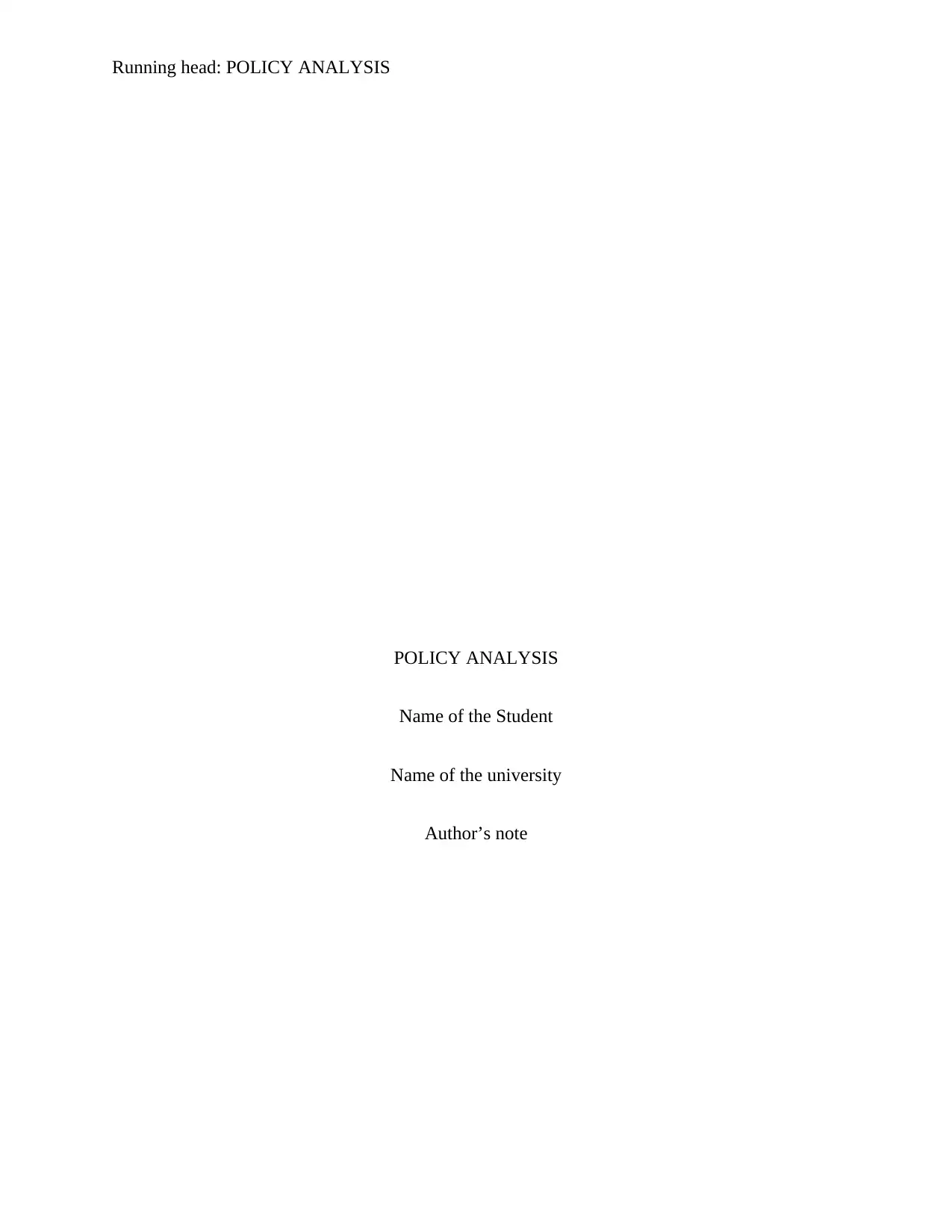
Running head: POLICY ANALYSIS
POLICY ANALYSIS
Name of the Student
Name of the university
Author’s note
POLICY ANALYSIS
Name of the Student
Name of the university
Author’s note
Paraphrase This Document
Need a fresh take? Get an instant paraphrase of this document with our AI Paraphraser

1POLICY ANALYSIS

2POLICY ANALYSIS
Table of Contents
Introduction......................................................................................................................................3
Demonstration of the policy........................................................................................................3
Reason for selecting the policy....................................................................................................5
Summary of the policy.................................................................................................................5
Policy analysis.................................................................................................................................6
Formulation of the problem.........................................................................................................6
Critical discussion and analysis.......................................................................................................9
Setting out of the objectives and the goals..................................................................................9
Identification of the decision parameters...................................................................................10
Resources...................................................................................................................................10
Alternatives................................................................................................................................11
Conclusion.....................................................................................................................................12
Recommendations..........................................................................................................................13
References......................................................................................................................................15
Table of Contents
Introduction......................................................................................................................................3
Demonstration of the policy........................................................................................................3
Reason for selecting the policy....................................................................................................5
Summary of the policy.................................................................................................................5
Policy analysis.................................................................................................................................6
Formulation of the problem.........................................................................................................6
Critical discussion and analysis.......................................................................................................9
Setting out of the objectives and the goals..................................................................................9
Identification of the decision parameters...................................................................................10
Resources...................................................................................................................................10
Alternatives................................................................................................................................11
Conclusion.....................................................................................................................................12
Recommendations..........................................................................................................................13
References......................................................................................................................................15
⊘ This is a preview!⊘
Do you want full access?
Subscribe today to unlock all pages.

Trusted by 1+ million students worldwide
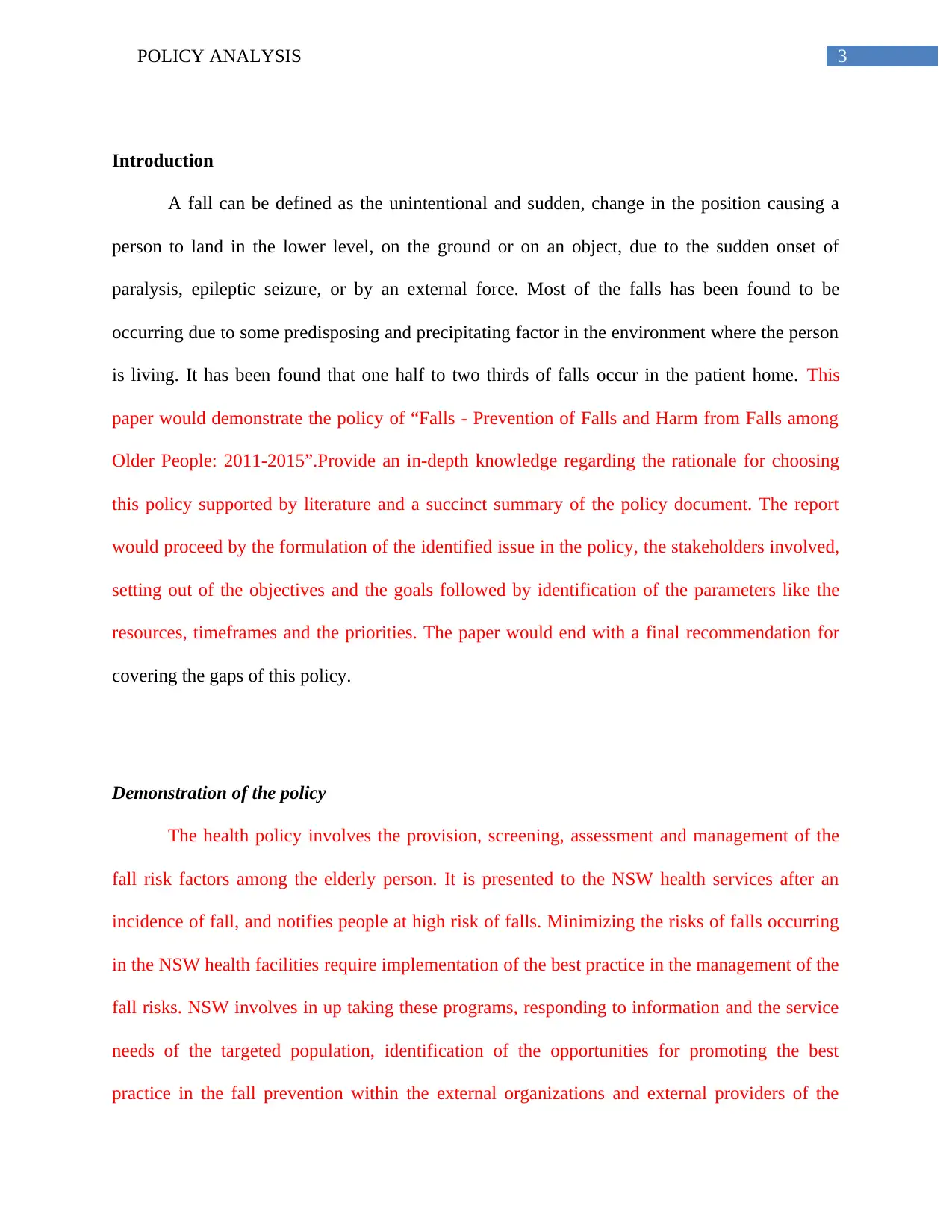
3POLICY ANALYSIS
Introduction
A fall can be defined as the unintentional and sudden, change in the position causing a
person to land in the lower level, on the ground or on an object, due to the sudden onset of
paralysis, epileptic seizure, or by an external force. Most of the falls has been found to be
occurring due to some predisposing and precipitating factor in the environment where the person
is living. It has been found that one half to two thirds of falls occur in the patient home. This
paper would demonstrate the policy of “Falls - Prevention of Falls and Harm from Falls among
Older People: 2011-2015”.Provide an in-depth knowledge regarding the rationale for choosing
this policy supported by literature and a succinct summary of the policy document. The report
would proceed by the formulation of the identified issue in the policy, the stakeholders involved,
setting out of the objectives and the goals followed by identification of the parameters like the
resources, timeframes and the priorities. The paper would end with a final recommendation for
covering the gaps of this policy.
Demonstration of the policy
The health policy involves the provision, screening, assessment and management of the
fall risk factors among the elderly person. It is presented to the NSW health services after an
incidence of fall, and notifies people at high risk of falls. Minimizing the risks of falls occurring
in the NSW health facilities require implementation of the best practice in the management of the
fall risks. NSW involves in up taking these programs, responding to information and the service
needs of the targeted population, identification of the opportunities for promoting the best
practice in the fall prevention within the external organizations and external providers of the
Introduction
A fall can be defined as the unintentional and sudden, change in the position causing a
person to land in the lower level, on the ground or on an object, due to the sudden onset of
paralysis, epileptic seizure, or by an external force. Most of the falls has been found to be
occurring due to some predisposing and precipitating factor in the environment where the person
is living. It has been found that one half to two thirds of falls occur in the patient home. This
paper would demonstrate the policy of “Falls - Prevention of Falls and Harm from Falls among
Older People: 2011-2015”.Provide an in-depth knowledge regarding the rationale for choosing
this policy supported by literature and a succinct summary of the policy document. The report
would proceed by the formulation of the identified issue in the policy, the stakeholders involved,
setting out of the objectives and the goals followed by identification of the parameters like the
resources, timeframes and the priorities. The paper would end with a final recommendation for
covering the gaps of this policy.
Demonstration of the policy
The health policy involves the provision, screening, assessment and management of the
fall risk factors among the elderly person. It is presented to the NSW health services after an
incidence of fall, and notifies people at high risk of falls. Minimizing the risks of falls occurring
in the NSW health facilities require implementation of the best practice in the management of the
fall risks. NSW involves in up taking these programs, responding to information and the service
needs of the targeted population, identification of the opportunities for promoting the best
practice in the fall prevention within the external organizations and external providers of the
Paraphrase This Document
Need a fresh take? Get an instant paraphrase of this document with our AI Paraphraser
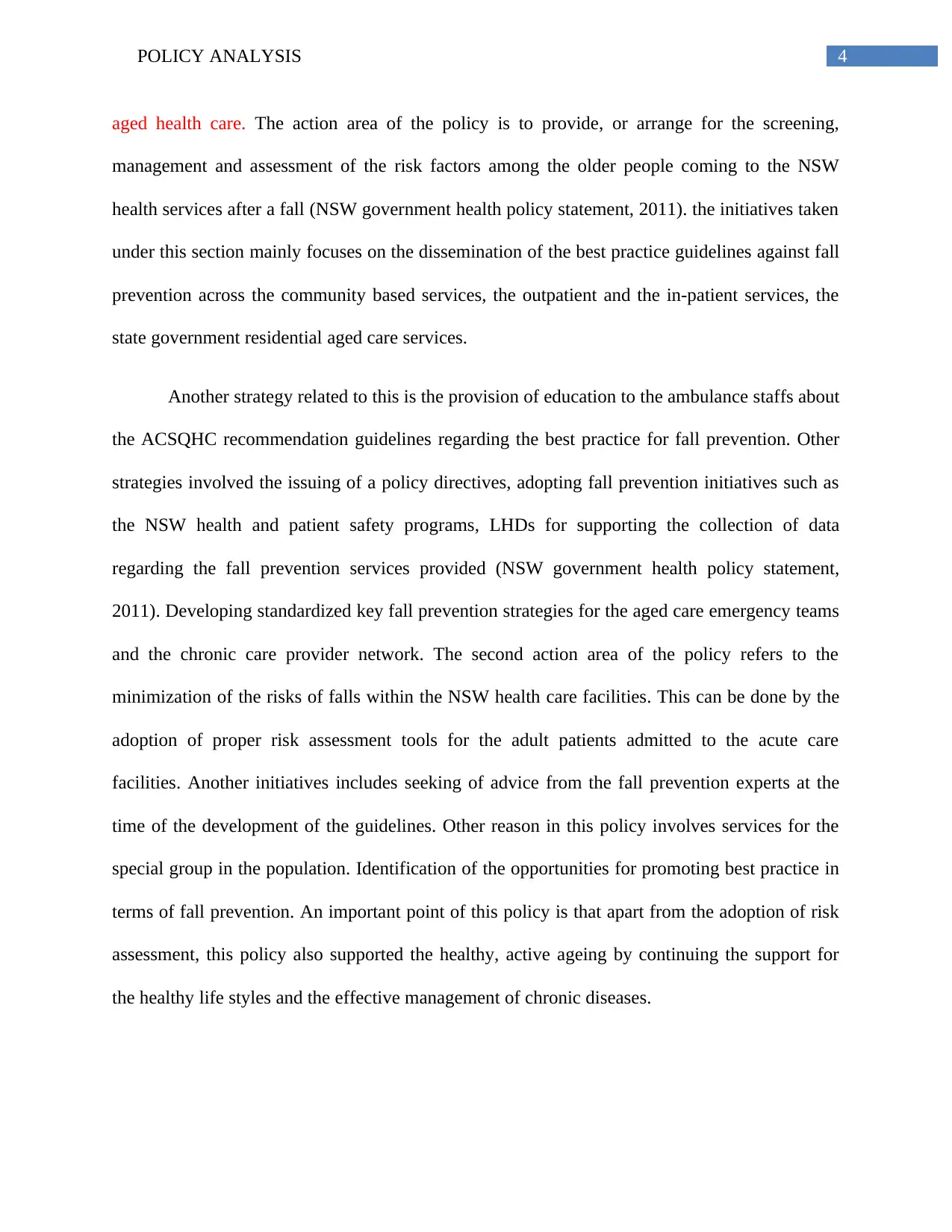
4POLICY ANALYSIS
aged health care. The action area of the policy is to provide, or arrange for the screening,
management and assessment of the risk factors among the older people coming to the NSW
health services after a fall (NSW government health policy statement, 2011). the initiatives taken
under this section mainly focuses on the dissemination of the best practice guidelines against fall
prevention across the community based services, the outpatient and the in-patient services, the
state government residential aged care services.
Another strategy related to this is the provision of education to the ambulance staffs about
the ACSQHC recommendation guidelines regarding the best practice for fall prevention. Other
strategies involved the issuing of a policy directives, adopting fall prevention initiatives such as
the NSW health and patient safety programs, LHDs for supporting the collection of data
regarding the fall prevention services provided (NSW government health policy statement,
2011). Developing standardized key fall prevention strategies for the aged care emergency teams
and the chronic care provider network. The second action area of the policy refers to the
minimization of the risks of falls within the NSW health care facilities. This can be done by the
adoption of proper risk assessment tools for the adult patients admitted to the acute care
facilities. Another initiatives includes seeking of advice from the fall prevention experts at the
time of the development of the guidelines. Other reason in this policy involves services for the
special group in the population. Identification of the opportunities for promoting best practice in
terms of fall prevention. An important point of this policy is that apart from the adoption of risk
assessment, this policy also supported the healthy, active ageing by continuing the support for
the healthy life styles and the effective management of chronic diseases.
aged health care. The action area of the policy is to provide, or arrange for the screening,
management and assessment of the risk factors among the older people coming to the NSW
health services after a fall (NSW government health policy statement, 2011). the initiatives taken
under this section mainly focuses on the dissemination of the best practice guidelines against fall
prevention across the community based services, the outpatient and the in-patient services, the
state government residential aged care services.
Another strategy related to this is the provision of education to the ambulance staffs about
the ACSQHC recommendation guidelines regarding the best practice for fall prevention. Other
strategies involved the issuing of a policy directives, adopting fall prevention initiatives such as
the NSW health and patient safety programs, LHDs for supporting the collection of data
regarding the fall prevention services provided (NSW government health policy statement,
2011). Developing standardized key fall prevention strategies for the aged care emergency teams
and the chronic care provider network. The second action area of the policy refers to the
minimization of the risks of falls within the NSW health care facilities. This can be done by the
adoption of proper risk assessment tools for the adult patients admitted to the acute care
facilities. Another initiatives includes seeking of advice from the fall prevention experts at the
time of the development of the guidelines. Other reason in this policy involves services for the
special group in the population. Identification of the opportunities for promoting best practice in
terms of fall prevention. An important point of this policy is that apart from the adoption of risk
assessment, this policy also supported the healthy, active ageing by continuing the support for
the healthy life styles and the effective management of chronic diseases.
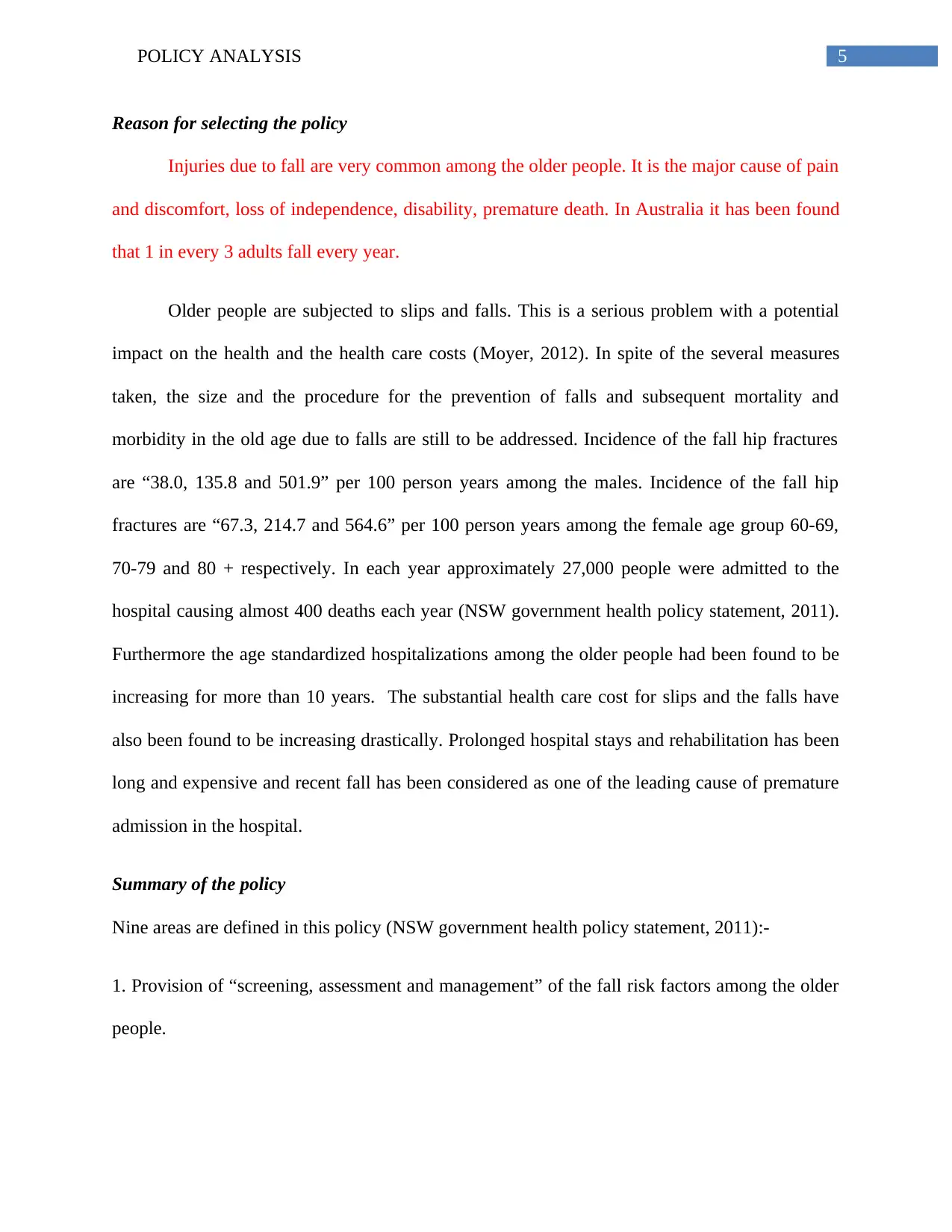
5POLICY ANALYSIS
Reason for selecting the policy
Injuries due to fall are very common among the older people. It is the major cause of pain
and discomfort, loss of independence, disability, premature death. In Australia it has been found
that 1 in every 3 adults fall every year.
Older people are subjected to slips and falls. This is a serious problem with a potential
impact on the health and the health care costs (Moyer, 2012). In spite of the several measures
taken, the size and the procedure for the prevention of falls and subsequent mortality and
morbidity in the old age due to falls are still to be addressed. Incidence of the fall hip fractures
are “38.0, 135.8 and 501.9” per 100 person years among the males. Incidence of the fall hip
fractures are “67.3, 214.7 and 564.6” per 100 person years among the female age group 60-69,
70-79 and 80 + respectively. In each year approximately 27,000 people were admitted to the
hospital causing almost 400 deaths each year (NSW government health policy statement, 2011).
Furthermore the age standardized hospitalizations among the older people had been found to be
increasing for more than 10 years. The substantial health care cost for slips and the falls have
also been found to be increasing drastically. Prolonged hospital stays and rehabilitation has been
long and expensive and recent fall has been considered as one of the leading cause of premature
admission in the hospital.
Summary of the policy
Nine areas are defined in this policy (NSW government health policy statement, 2011):-
1. Provision of “screening, assessment and management” of the fall risk factors among the older
people.
Reason for selecting the policy
Injuries due to fall are very common among the older people. It is the major cause of pain
and discomfort, loss of independence, disability, premature death. In Australia it has been found
that 1 in every 3 adults fall every year.
Older people are subjected to slips and falls. This is a serious problem with a potential
impact on the health and the health care costs (Moyer, 2012). In spite of the several measures
taken, the size and the procedure for the prevention of falls and subsequent mortality and
morbidity in the old age due to falls are still to be addressed. Incidence of the fall hip fractures
are “38.0, 135.8 and 501.9” per 100 person years among the males. Incidence of the fall hip
fractures are “67.3, 214.7 and 564.6” per 100 person years among the female age group 60-69,
70-79 and 80 + respectively. In each year approximately 27,000 people were admitted to the
hospital causing almost 400 deaths each year (NSW government health policy statement, 2011).
Furthermore the age standardized hospitalizations among the older people had been found to be
increasing for more than 10 years. The substantial health care cost for slips and the falls have
also been found to be increasing drastically. Prolonged hospital stays and rehabilitation has been
long and expensive and recent fall has been considered as one of the leading cause of premature
admission in the hospital.
Summary of the policy
Nine areas are defined in this policy (NSW government health policy statement, 2011):-
1. Provision of “screening, assessment and management” of the fall risk factors among the older
people.
⊘ This is a preview!⊘
Do you want full access?
Subscribe today to unlock all pages.

Trusted by 1+ million students worldwide
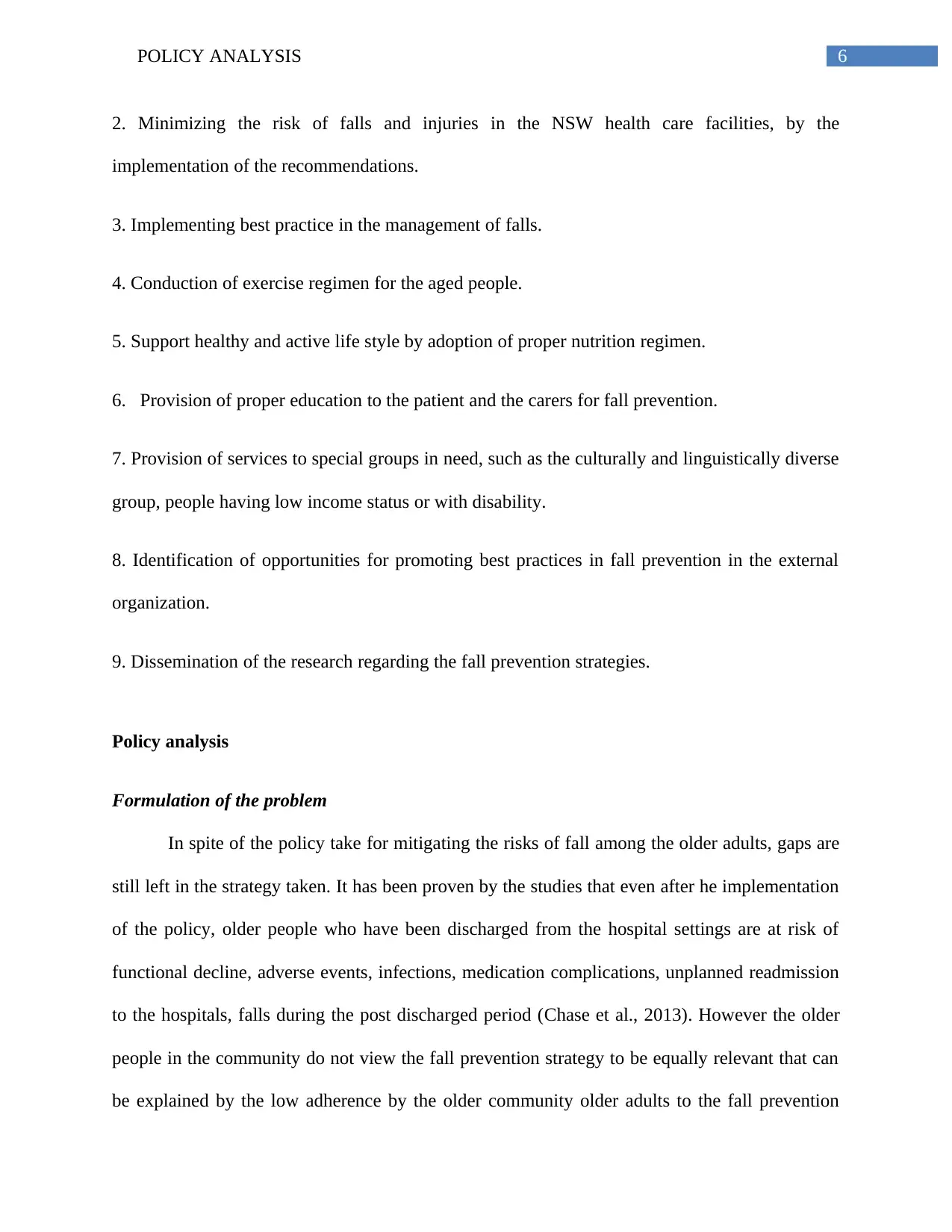
6POLICY ANALYSIS
2. Minimizing the risk of falls and injuries in the NSW health care facilities, by the
implementation of the recommendations.
3. Implementing best practice in the management of falls.
4. Conduction of exercise regimen for the aged people.
5. Support healthy and active life style by adoption of proper nutrition regimen.
6. Provision of proper education to the patient and the carers for fall prevention.
7. Provision of services to special groups in need, such as the culturally and linguistically diverse
group, people having low income status or with disability.
8. Identification of opportunities for promoting best practices in fall prevention in the external
organization.
9. Dissemination of the research regarding the fall prevention strategies.
Policy analysis
Formulation of the problem
In spite of the policy take for mitigating the risks of fall among the older adults, gaps are
still left in the strategy taken. It has been proven by the studies that even after he implementation
of the policy, older people who have been discharged from the hospital settings are at risk of
functional decline, adverse events, infections, medication complications, unplanned readmission
to the hospitals, falls during the post discharged period (Chase et al., 2013). However the older
people in the community do not view the fall prevention strategy to be equally relevant that can
be explained by the low adherence by the older community older adults to the fall prevention
2. Minimizing the risk of falls and injuries in the NSW health care facilities, by the
implementation of the recommendations.
3. Implementing best practice in the management of falls.
4. Conduction of exercise regimen for the aged people.
5. Support healthy and active life style by adoption of proper nutrition regimen.
6. Provision of proper education to the patient and the carers for fall prevention.
7. Provision of services to special groups in need, such as the culturally and linguistically diverse
group, people having low income status or with disability.
8. Identification of opportunities for promoting best practices in fall prevention in the external
organization.
9. Dissemination of the research regarding the fall prevention strategies.
Policy analysis
Formulation of the problem
In spite of the policy take for mitigating the risks of fall among the older adults, gaps are
still left in the strategy taken. It has been proven by the studies that even after he implementation
of the policy, older people who have been discharged from the hospital settings are at risk of
functional decline, adverse events, infections, medication complications, unplanned readmission
to the hospitals, falls during the post discharged period (Chase et al., 2013). However the older
people in the community do not view the fall prevention strategy to be equally relevant that can
be explained by the low adherence by the older community older adults to the fall prevention
Paraphrase This Document
Need a fresh take? Get an instant paraphrase of this document with our AI Paraphraser

7POLICY ANALYSIS
strategies (NSW government health policy statement, 2011). Hence this can provide rationale to
the fact that the strategies taken for educating the patients about the fall prevention strategies
have not been successful.
The policy did not provide any information about the cost estimation regarding the
implementation of the initiatives (Moyer, 2012). Other program gaps in the fall prevention
strategies for the older adults involves the recommendations for the use of restraints in case of
the older adults. Fall prevention committees should be careful about the any long term and the
short term goals to transition any kind of restraint out of the structure of the community wall and
culture (Chase et al., 2013). Fall prevention strategies often overlook the importance of the
environmental factors throughout the living spaces of the residences. Uneven floors, rugs in the
bathrooms and crowded living rooms with big furniture and can lead to falls in the older adults
(Inouye et al., 2013). The policy did not emphasize on the environmental fall risk assessment
performed in the resident rooms or the living areas. Another limitation of this policy is that it did
not emphasize on the work force of the clinical settings. It has been found that the low workforce
in a clinical setting is directly proportional to the occurrence of the adverse events (Hempel et al.,
2014). The policy also did not provide a detailed explanation of any health monitoring
technologies such as provision of the sensors and monitors. It has been found that that discreetly
place data can be useful in providing information to the staff members regarding the unusual gait
changes, increased heart rate and increased early symptoms of illness that can lead to fall
(Cameron et al., 2012). One of the gap that has been identified is that the policy did not identify
any community based health groups that would assist in providing care to the fall prone elderly
in need (Hempel et al., 2014).. Social workers have to collaborate with the health care team in
identifying the people who are unable to approach any clinical settings and remoteness. It is
strategies (NSW government health policy statement, 2011). Hence this can provide rationale to
the fact that the strategies taken for educating the patients about the fall prevention strategies
have not been successful.
The policy did not provide any information about the cost estimation regarding the
implementation of the initiatives (Moyer, 2012). Other program gaps in the fall prevention
strategies for the older adults involves the recommendations for the use of restraints in case of
the older adults. Fall prevention committees should be careful about the any long term and the
short term goals to transition any kind of restraint out of the structure of the community wall and
culture (Chase et al., 2013). Fall prevention strategies often overlook the importance of the
environmental factors throughout the living spaces of the residences. Uneven floors, rugs in the
bathrooms and crowded living rooms with big furniture and can lead to falls in the older adults
(Inouye et al., 2013). The policy did not emphasize on the environmental fall risk assessment
performed in the resident rooms or the living areas. Another limitation of this policy is that it did
not emphasize on the work force of the clinical settings. It has been found that the low workforce
in a clinical setting is directly proportional to the occurrence of the adverse events (Hempel et al.,
2014). The policy also did not provide a detailed explanation of any health monitoring
technologies such as provision of the sensors and monitors. It has been found that that discreetly
place data can be useful in providing information to the staff members regarding the unusual gait
changes, increased heart rate and increased early symptoms of illness that can lead to fall
(Cameron et al., 2012). One of the gap that has been identified is that the policy did not identify
any community based health groups that would assist in providing care to the fall prone elderly
in need (Hempel et al., 2014).. Social workers have to collaborate with the health care team in
identifying the people who are unable to approach any clinical settings and remoteness. It is
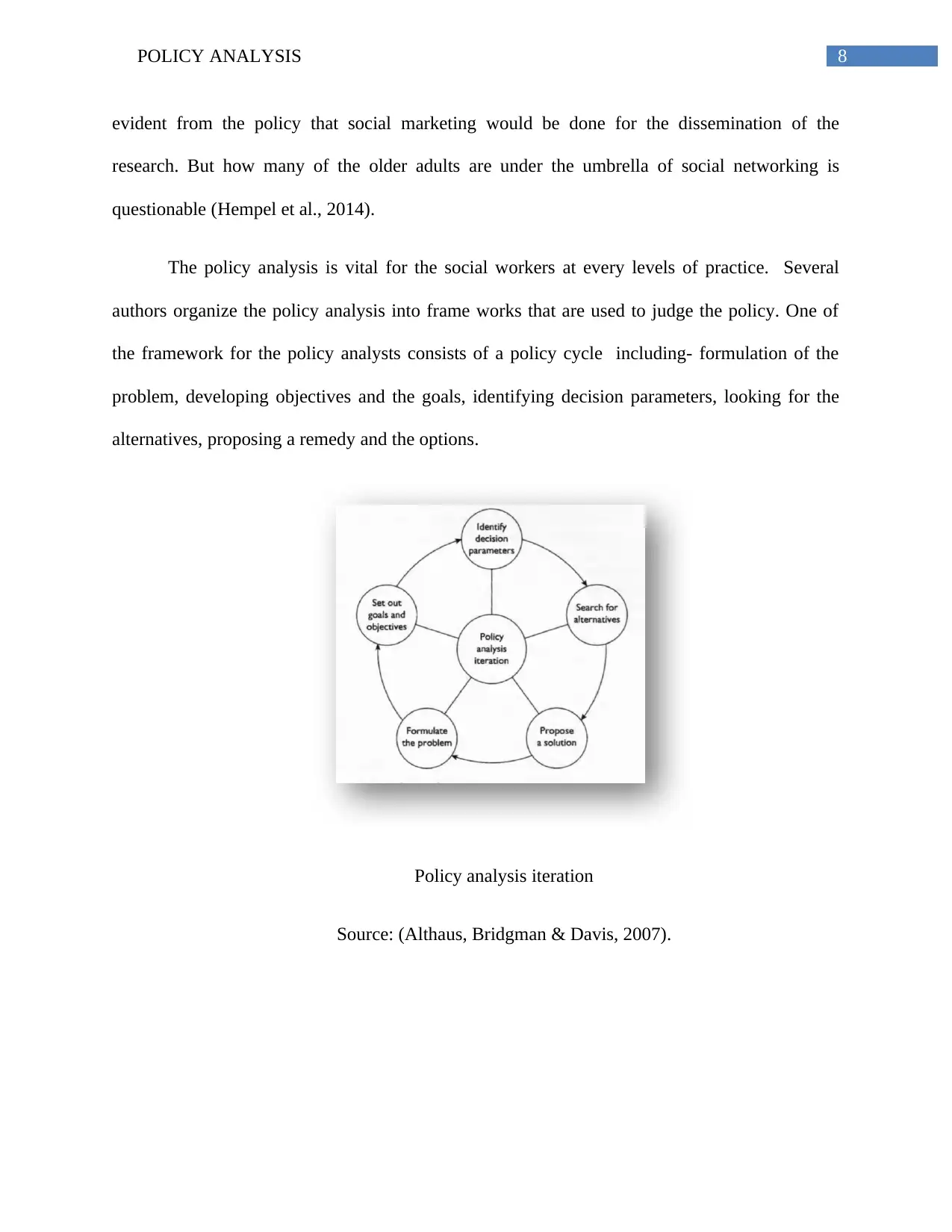
8POLICY ANALYSIS
evident from the policy that social marketing would be done for the dissemination of the
research. But how many of the older adults are under the umbrella of social networking is
questionable (Hempel et al., 2014).
The policy analysis is vital for the social workers at every levels of practice. Several
authors organize the policy analysis into frame works that are used to judge the policy. One of
the framework for the policy analysts consists of a policy cycle including- formulation of the
problem, developing objectives and the goals, identifying decision parameters, looking for the
alternatives, proposing a remedy and the options.
Policy analysis iteration
Source: (Althaus, Bridgman & Davis, 2007).
evident from the policy that social marketing would be done for the dissemination of the
research. But how many of the older adults are under the umbrella of social networking is
questionable (Hempel et al., 2014).
The policy analysis is vital for the social workers at every levels of practice. Several
authors organize the policy analysis into frame works that are used to judge the policy. One of
the framework for the policy analysts consists of a policy cycle including- formulation of the
problem, developing objectives and the goals, identifying decision parameters, looking for the
alternatives, proposing a remedy and the options.
Policy analysis iteration
Source: (Althaus, Bridgman & Davis, 2007).
⊘ This is a preview!⊘
Do you want full access?
Subscribe today to unlock all pages.

Trusted by 1+ million students worldwide
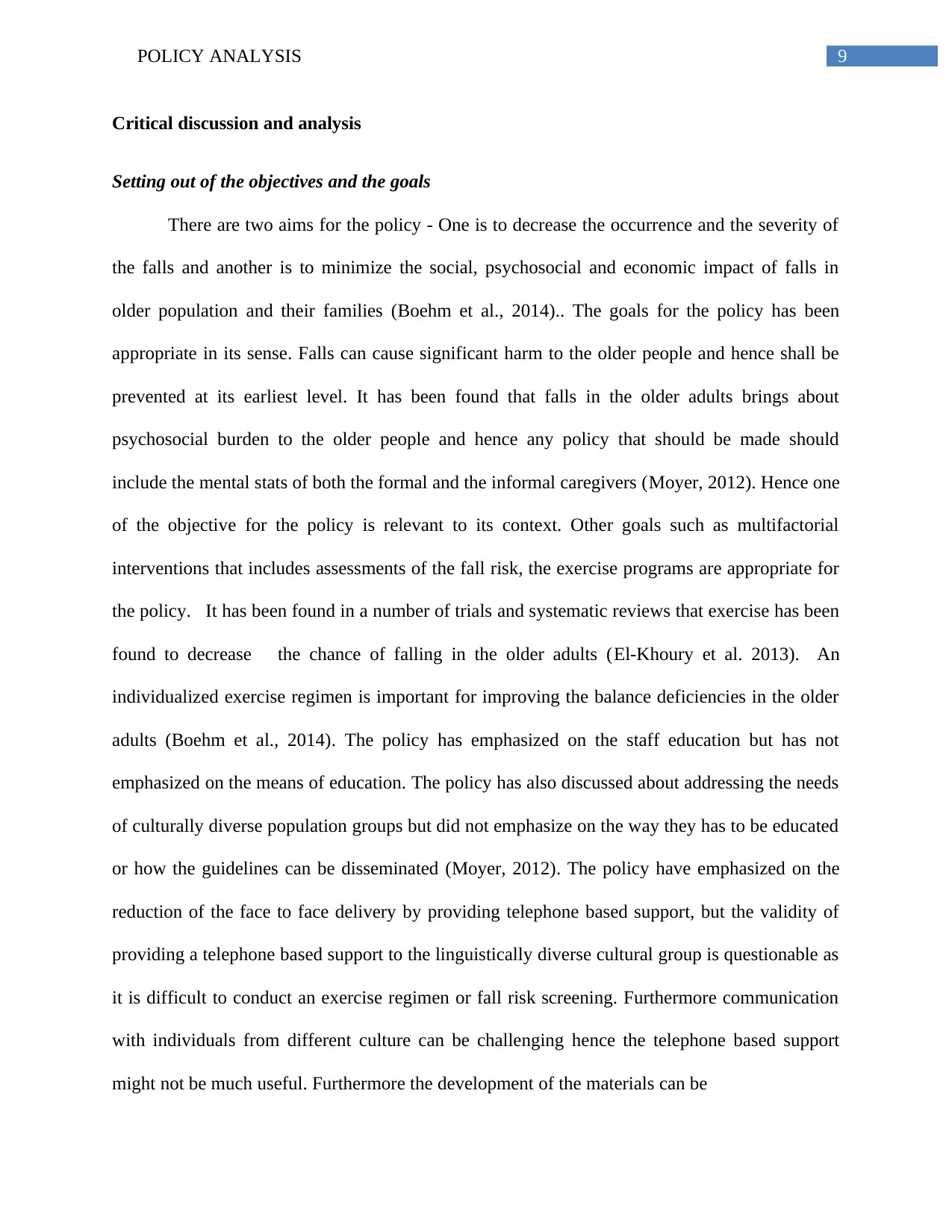
9POLICY ANALYSIS
Critical discussion and analysis
Setting out of the objectives and the goals
There are two aims for the policy - One is to decrease the occurrence and the severity of
the falls and another is to minimize the social, psychosocial and economic impact of falls in
older population and their families (Boehm et al., 2014).. The goals for the policy has been
appropriate in its sense. Falls can cause significant harm to the older people and hence shall be
prevented at its earliest level. It has been found that falls in the older adults brings about
psychosocial burden to the older people and hence any policy that should be made should
include the mental stats of both the formal and the informal caregivers (Moyer, 2012). Hence one
of the objective for the policy is relevant to its context. Other goals such as multifactorial
interventions that includes assessments of the fall risk, the exercise programs are appropriate for
the policy. It has been found in a number of trials and systematic reviews that exercise has been
found to decrease the chance of falling in the older adults (El-Khoury et al. 2013). An
individualized exercise regimen is important for improving the balance deficiencies in the older
adults (Boehm et al., 2014). The policy has emphasized on the staff education but has not
emphasized on the means of education. The policy has also discussed about addressing the needs
of culturally diverse population groups but did not emphasize on the way they has to be educated
or how the guidelines can be disseminated (Moyer, 2012). The policy have emphasized on the
reduction of the face to face delivery by providing telephone based support, but the validity of
providing a telephone based support to the linguistically diverse cultural group is questionable as
it is difficult to conduct an exercise regimen or fall risk screening. Furthermore communication
with individuals from different culture can be challenging hence the telephone based support
might not be much useful. Furthermore the development of the materials can be
Critical discussion and analysis
Setting out of the objectives and the goals
There are two aims for the policy - One is to decrease the occurrence and the severity of
the falls and another is to minimize the social, psychosocial and economic impact of falls in
older population and their families (Boehm et al., 2014).. The goals for the policy has been
appropriate in its sense. Falls can cause significant harm to the older people and hence shall be
prevented at its earliest level. It has been found that falls in the older adults brings about
psychosocial burden to the older people and hence any policy that should be made should
include the mental stats of both the formal and the informal caregivers (Moyer, 2012). Hence one
of the objective for the policy is relevant to its context. Other goals such as multifactorial
interventions that includes assessments of the fall risk, the exercise programs are appropriate for
the policy. It has been found in a number of trials and systematic reviews that exercise has been
found to decrease the chance of falling in the older adults (El-Khoury et al. 2013). An
individualized exercise regimen is important for improving the balance deficiencies in the older
adults (Boehm et al., 2014). The policy has emphasized on the staff education but has not
emphasized on the means of education. The policy has also discussed about addressing the needs
of culturally diverse population groups but did not emphasize on the way they has to be educated
or how the guidelines can be disseminated (Moyer, 2012). The policy have emphasized on the
reduction of the face to face delivery by providing telephone based support, but the validity of
providing a telephone based support to the linguistically diverse cultural group is questionable as
it is difficult to conduct an exercise regimen or fall risk screening. Furthermore communication
with individuals from different culture can be challenging hence the telephone based support
might not be much useful. Furthermore the development of the materials can be
Paraphrase This Document
Need a fresh take? Get an instant paraphrase of this document with our AI Paraphraser

10POLICY ANALYSIS
Identification of the decision parameters
There are several parameters that guides the credibility of the policies and makes them
acceptable. It is this parameters that decides whether this policy has to be implemented or not.
The parameters helps the analysts to decide how much time and attention should be given to a
problem. The clear cut identification of the parameters help them to identify the issue and the
time that a problem deserves.
Resources
The resources that have been used for this policy included written fall prevention control
materials, printed resources, training and the resources for assisting the health professionals in
communicating key messages to the elderly people. The policy did not provide much information
regarding the budget that would be required for implementing this practice. It has only been
mentioned that the Clinical excellence program would get the funding from the NSW department
of health for the supporting the local health districts through program (Robertson & Gillespie,
2013).
If policies are the outcome of the choices that the entities make to achieve their goals.
The legislation and the budgetary process is the important factor of a policy implementation. It is
important to understand how the system operates at various levels, as not all the policies comes
in to effect through the law making process. The budget is one of the important policy document
in any government and it shows how the government allocates the resources among the various
needs. The policy did not provide an insight to how the budget would be distributed in this
program. Furthermore politics is another parameter that decides what has to be done, what, when
and how. It is government officials that has to decide on the funding and for that they should be
provided with a clear estimation of the spending which is absent in this report (Miake-Lye et al.,
Identification of the decision parameters
There are several parameters that guides the credibility of the policies and makes them
acceptable. It is this parameters that decides whether this policy has to be implemented or not.
The parameters helps the analysts to decide how much time and attention should be given to a
problem. The clear cut identification of the parameters help them to identify the issue and the
time that a problem deserves.
Resources
The resources that have been used for this policy included written fall prevention control
materials, printed resources, training and the resources for assisting the health professionals in
communicating key messages to the elderly people. The policy did not provide much information
regarding the budget that would be required for implementing this practice. It has only been
mentioned that the Clinical excellence program would get the funding from the NSW department
of health for the supporting the local health districts through program (Robertson & Gillespie,
2013).
If policies are the outcome of the choices that the entities make to achieve their goals.
The legislation and the budgetary process is the important factor of a policy implementation. It is
important to understand how the system operates at various levels, as not all the policies comes
in to effect through the law making process. The budget is one of the important policy document
in any government and it shows how the government allocates the resources among the various
needs. The policy did not provide an insight to how the budget would be distributed in this
program. Furthermore politics is another parameter that decides what has to be done, what, when
and how. It is government officials that has to decide on the funding and for that they should be
provided with a clear estimation of the spending which is absent in this report (Miake-Lye et al.,
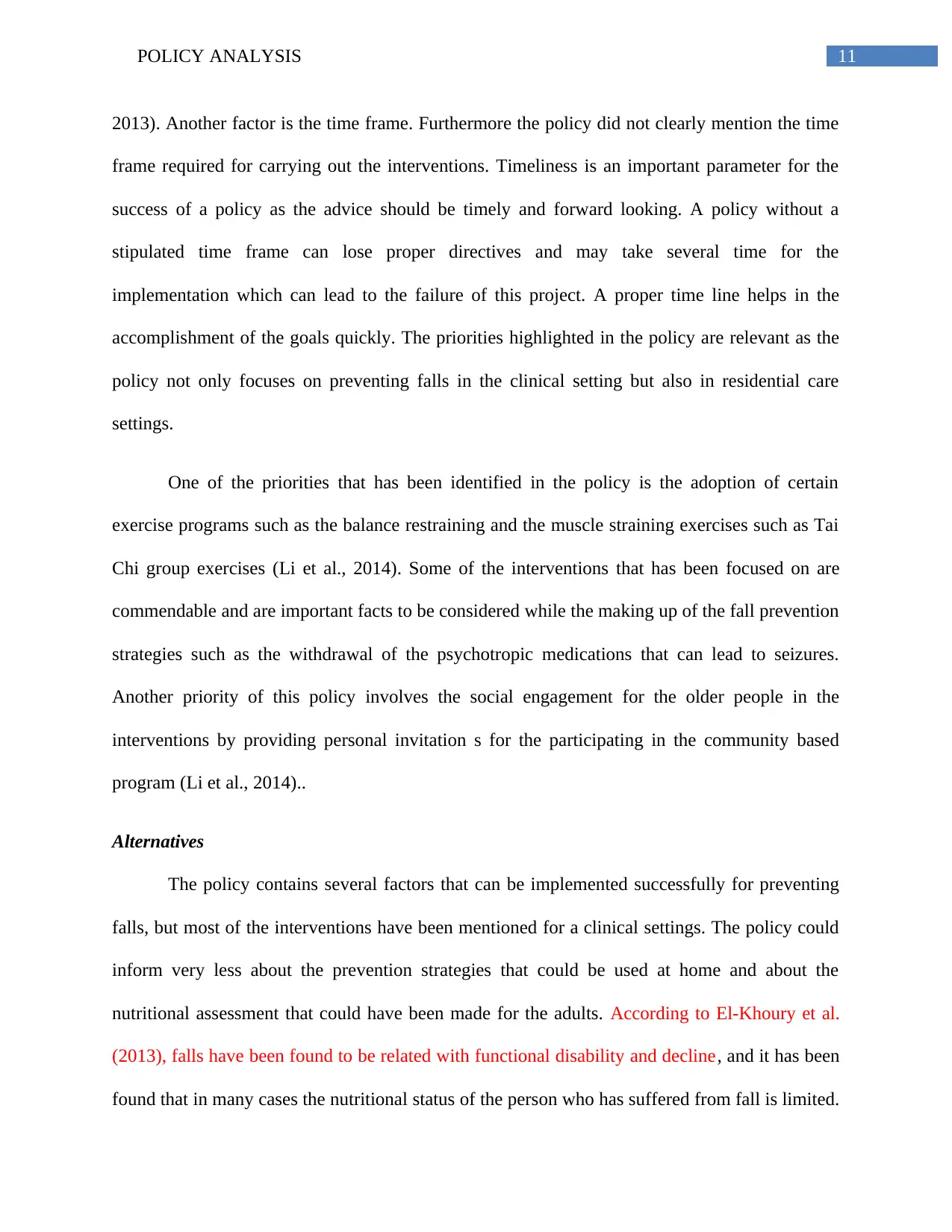
11POLICY ANALYSIS
2013). Another factor is the time frame. Furthermore the policy did not clearly mention the time
frame required for carrying out the interventions. Timeliness is an important parameter for the
success of a policy as the advice should be timely and forward looking. A policy without a
stipulated time frame can lose proper directives and may take several time for the
implementation which can lead to the failure of this project. A proper time line helps in the
accomplishment of the goals quickly. The priorities highlighted in the policy are relevant as the
policy not only focuses on preventing falls in the clinical setting but also in residential care
settings.
One of the priorities that has been identified in the policy is the adoption of certain
exercise programs such as the balance restraining and the muscle straining exercises such as Tai
Chi group exercises (Li et al., 2014). Some of the interventions that has been focused on are
commendable and are important facts to be considered while the making up of the fall prevention
strategies such as the withdrawal of the psychotropic medications that can lead to seizures.
Another priority of this policy involves the social engagement for the older people in the
interventions by providing personal invitation s for the participating in the community based
program (Li et al., 2014)..
Alternatives
The policy contains several factors that can be implemented successfully for preventing
falls, but most of the interventions have been mentioned for a clinical settings. The policy could
inform very less about the prevention strategies that could be used at home and about the
nutritional assessment that could have been made for the adults. According to El-Khoury et al.
(2013), falls have been found to be related with functional disability and decline, and it has been
found that in many cases the nutritional status of the person who has suffered from fall is limited.
2013). Another factor is the time frame. Furthermore the policy did not clearly mention the time
frame required for carrying out the interventions. Timeliness is an important parameter for the
success of a policy as the advice should be timely and forward looking. A policy without a
stipulated time frame can lose proper directives and may take several time for the
implementation which can lead to the failure of this project. A proper time line helps in the
accomplishment of the goals quickly. The priorities highlighted in the policy are relevant as the
policy not only focuses on preventing falls in the clinical setting but also in residential care
settings.
One of the priorities that has been identified in the policy is the adoption of certain
exercise programs such as the balance restraining and the muscle straining exercises such as Tai
Chi group exercises (Li et al., 2014). Some of the interventions that has been focused on are
commendable and are important facts to be considered while the making up of the fall prevention
strategies such as the withdrawal of the psychotropic medications that can lead to seizures.
Another priority of this policy involves the social engagement for the older people in the
interventions by providing personal invitation s for the participating in the community based
program (Li et al., 2014)..
Alternatives
The policy contains several factors that can be implemented successfully for preventing
falls, but most of the interventions have been mentioned for a clinical settings. The policy could
inform very less about the prevention strategies that could be used at home and about the
nutritional assessment that could have been made for the adults. According to El-Khoury et al.
(2013), falls have been found to be related with functional disability and decline, and it has been
found that in many cases the nutritional status of the person who has suffered from fall is limited.
⊘ This is a preview!⊘
Do you want full access?
Subscribe today to unlock all pages.

Trusted by 1+ million students worldwide
1 out of 19
Related Documents
Your All-in-One AI-Powered Toolkit for Academic Success.
+13062052269
info@desklib.com
Available 24*7 on WhatsApp / Email
![[object Object]](/_next/static/media/star-bottom.7253800d.svg)
Unlock your academic potential
Copyright © 2020–2025 A2Z Services. All Rights Reserved. Developed and managed by ZUCOL.



